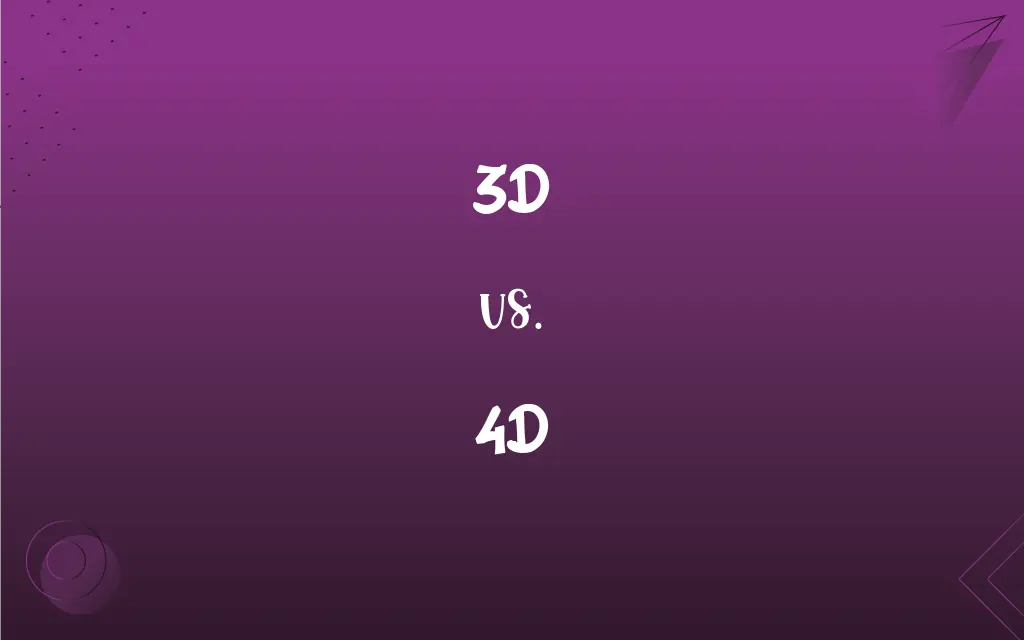3D vs. 4D: What's the Difference?
Edited by Aimie Carlson || By Janet White || Published on November 28, 2023
3D refers to three-dimensional space, incorporating height, width, and depth, while 4D adds the dimension of time or temporal change to 3D space.

Key Differences
3D represents three spatial dimensions: height, width, and depth, creating a sense of physical reality in images or objects. In contrast, 4D builds upon 3D by incorporating time as a fourth dimension, often used in dynamic simulations or experiences.
3D is widely used in computer graphics, architecture, and film to create lifelike representations. 4D extends these representations by adding movement or change over time, as seen in 4D cinema experiences or complex scientific visualizations.
In 3D printing, objects are created in three dimensions, offering tangible models. 4D printing introduces materials that change shape or function over time when exposed to external stimuli, like heat or water.
The concept of 3D is easier to visualize and is commonly experienced in everyday life, from sculptures to video games. 4D concepts, while rooted in 3D, require a more abstract understanding, often linked to time-based processes or changes.
Virtual reality often uses 3D for immersive environments, while augmented reality can use 4D to overlay time-based data or changes onto the real world, enhancing user interaction with both spatial and temporal elements.
ADVERTISEMENT
Comparison Chart
Dimensionality
Three dimensions (height, width, depth)
Four dimensions (height, width, depth, time)
Common Usage
In graphics, modeling, and gaming
In dynamic simulations and time-based experiences
Real-world Example
3D movies, 3D printing
4D cinema, 4D printing
Visualization
Tangible and easily visualized
Requires abstract thought for time aspect
Technology Application
Used in VR and static modeling
Used in AR and dynamic, responsive designs
ADVERTISEMENT
3D and 4D Definitions
3D
Pertaining to three spatial dimensions.
The architect designed the building in 3D to visualize its structure.
4D
In printing, creating objects that transform with time or conditions.
They used 4D printing for materials that adapt to environmental changes.
3D
A technique in movies to enhance visual depth.
We watched the movie in 3D to experience the special effects.
4D
Incorporating time as an additional dimension to 3D.
The 4D simulation showed how the climate has changed over decades.
3D
Related to the physical form of objects.
The sculpture is a perfect example of 3D art.
4D
In virtual environments, adding real-time changes or interactions.
The 4D VR game changes based on the player's decisions.
3D
Used in computer graphics to create depth.
The 3D animation looked stunningly realistic.
4D
Used in cinema to introduce temporal and sensory experiences.
The 4D movie experience included moving seats and scents.
3D
Utilized in printing to create three-dimensional objects.
The prototype was created using a 3D printer.
4D
Pertaining to dynamic models that change over time.
The 4D model displayed how the building would age.
3D
Three-dimensional.
3D
A three-dimensional medium, display, or performance, especially a cinematic or graphic medium in three dimensions
They shot the movie in 3D.
3D
Abbreviation of three-dimensional
3D
Thruppence, threepence, a coin valuing three pennies
3D
A movie with images having three dimensional form or appearance
3D
Having a three-dimensional form or appearance;
Aren't dreams always in 3-D?
FAQs
Can 3D be experienced without special equipment?
Generally, 3D visuals require special glasses or screens to be fully experienced.
How is 3D used in movies?
3D movies use special effects to give depth and a more immersive experience.
What is 4D cinema?
4D cinema includes 3D visuals plus physical effects like motion, wind, or scents.
What does 3D stand for?
3D stands for three-dimensional, encompassing height, width, and depth.
What is the meaning of 4D?
4D means four-dimensional, including the three spatial dimensions plus time.
Is 4D technology widely available?
4D is less common and typically found in specialized settings like 4D theaters.
Is 3D printing affordable for personal use?
Yes, many affordable 3D printers are available for personal and hobbyist use.
What's the difference between 3D and 4D printing?
3D printing creates static objects, while 4D printing produces items that change over time.
Are 3D graphics used in video games?
Yes, many video games use 3D graphics for realistic environments.
How do 3D glasses work?
3D glasses enable each eye to see a slightly different image, creating a depth illusion.
Can 4D be experienced at home?
Some home theater systems offer 4D experiences with additional equipment.
How is 4D used in augmented reality?
4D in AR can overlay time-based data or changes onto the real world.
What skills are needed for 3D modeling?
Skills in graphic design and software proficiency are needed for 3D modeling.
What applications use 4D technology?
4D technology is used in simulations, dynamic modeling, and enhanced VR/AR experiences.
How does 4D benefit scientific research?
4D helps in understanding complex processes that change over time.
Is there a future for 3D and 4D in entertainment?
Both 3D and 4D have growing potential in creating more immersive entertainment experiences.
What's a practical use of 3D technology?
3D technology is used in architecture and medicine for accurate visualizations.
What makes 4D printing innovative?
4D printing is innovative due to its ability to create objects that respond to stimuli.
Do 3D and 4D refer only to visual experiences?
While often visual, these terms can also apply to physical and interactive experiences.
Can 4D be used in education?
Yes, 4D can enhance learning by simulating historical events or scientific phenomena.
About Author
Written by
Janet WhiteJanet White has been an esteemed writer and blogger for Difference Wiki. Holding a Master's degree in Science and Medical Journalism from the prestigious Boston University, she has consistently demonstrated her expertise and passion for her field. When she's not immersed in her work, Janet relishes her time exercising, delving into a good book, and cherishing moments with friends and family.
Edited by
Aimie CarlsonAimie Carlson, holding a master's degree in English literature, is a fervent English language enthusiast. She lends her writing talents to Difference Wiki, a prominent website that specializes in comparisons, offering readers insightful analyses that both captivate and inform.






































































